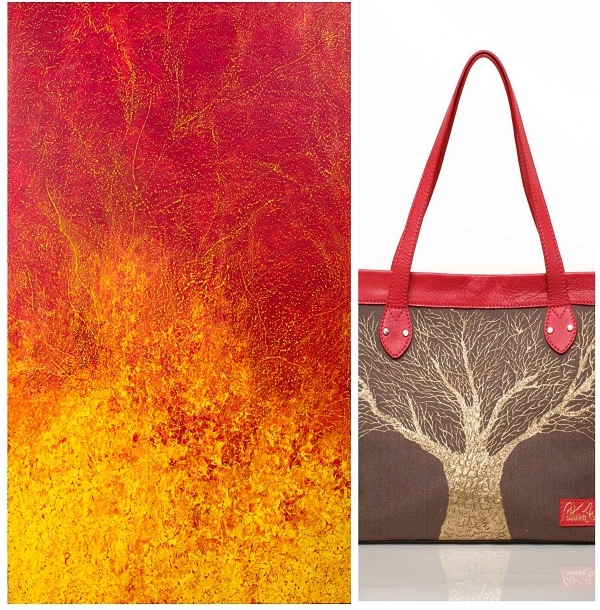What kind of artist do you want to be?
Until recently, I didn’t realize that there are two different ways to approach art: mindfulness art and awareness art.
Reading True Perception–The Path of Dharma Art by Chögyam Trungpa sparked an aha moment for me. I gained complete clarity on why I’d discontinued my hand-painted accessories business. It also made me realize that I practice both approaches to art.
On a gloomy day, many years ago, I sat by Lake Washington, and sketched a tree that was staring me in the face. Weeks later, I observed that one of my old canvas bags was looking dilapidated and needed refreshment. I looked at the sketch and decided to paint the tree design on the bag.
I received several compliments on it—even from strangers.
I happened to run into someone who manufactured bags when I was visiting India a couple of months later. I collaborated with the individual to design a small batch of bags, brought them back to the United States, and started painting them. The brand “Pittura Arte” was born organically in 2013.
When I created my first collection of hand-painted bags, I did not think about what people wanted to buy. I painted what my heart desired. I created as if there was no goal. No target. No money to be made.
I created my first collection with an awareness or vipashyana approach as described by Trungpa.
A meditative process:
That which flows, without a purpose or a goal.
That which has no end game.
That which is not created to be appreciated or sold.
As one creates art of this nature, there is nothing but breath and sensation. The entire mind and body are one with creation. This type of art tends to be devoid of conscious thought.
Pure, unbridled writing from the heart in a journal, or music produced with no purpose but for the pure joy of being one with rhythm and melody, are other examples of awareness art.
Even though there was an intention to exhibit my bags (which tends not to be part of the awareness approach), I did not pose any restrictions on myself as I created my first collection.
As time progressed, however, I realized that to make a profit, I would need to create what people desired—supply and demand. I had to keep track of market trends. My creative process became restrictive. There was a goal in sight. A target to hit. Money to be made.
At this time, the mindfulness or shamatha approach came into play.
Art with a clear purpose:
That which is designed to be of benefit to the consumer.
That which is mindful in nature.
That which is exhibitionist in nature.
That which has restrictions attached to it.
I had to figure out what the most popular designs were, paint a certain number of bags, and ensure that the bags were marketed effectively, resulting in sales. Also, when it comes to wearable art, there are constraints in the shape and size of the artwork to consider. And so, painting on bags was different from what I used to do, which was more like fine art on a canvas, where the world was my oyster.
Freedom had existed in my mindfulness approach, but it was constrained due to demands and requirements that were placed on results.
And this is what happened with “Pittura Arte.” The business required me to spend way more time on mindfulness art instead of awareness art. This balance did not work well for my inner nature, which is that of an artist, rather than an entrepreneur.
I ventured into it out of my love for creation, not a love for entrepreneurship. Once restrictions were placed on my creation, I was gradually stifled. It was no longer a joyful process.
In 2105, I decided to stop getting more bags manufactured. My business was conducted on a small scale, and in the end, I broke even. I still do custom work for folks who have the same design sense as I do.
The mindfulness approach to art did not work for me with respect to painting. However, it does work for me with respect to writing.
I write articles, just as this one, combining an awareness and mindfulness approach.
I start with unrestrained writing—scribbling my thoughts and feelings on a topic I am passionate about. It’s a flow of words with no purpose. This is awareness art.
And then I bring in a mindfulness approach by delving into what would be beneficial for readers, and how I can make my words more accessible and approachable to them.
Trungpa speaks to the benefits of practicing the awareness approach but does not label the mindfulness approach as wrong.
As artists, we can play around with a permutation and combination of mindfulness and awareness approaches to art and figure out what works best for us.
I would urge all artists to spend some time solely on awareness art for these three reasons, as described by Trungpa:
1. When we start practicing awareness art, we start appreciating art in everyday life. We see art in everything around us—even in mundane chores such as washing the dishes and folding the laundry. We experience the same thing in a unique way every time we do it. And it tends to feel like bliss.
2. By having an awareness experience in art, we can transcend any aggression that may exist within us. According to Trungpa, transcending aggression is the root of all the artist talent one can ever imagine.
As human beings, we all have a certain amount of aggression and anger within us. However, aggression and anger are not treated the same way in this context. If anger inspires a work of art, there is generosity and awareness involved in it. And art is not always about creating beauty. It is about anything “workable” or “rich.”
3. Trungpa states, “Awareness practice is not just sitting meditation or meditation-in-action alone. It is a unique training practice in how to behave as an inspired human being. That is what is meant by being an artist.”
My first love will always be an awareness approach to art, as it puts me in a blissful state every single time. But there are areas where I bring both awareness and mindfulness art together, and it feels like bliss too.
Experiment, reflect, and be true to your inner nature!
~











Read 6 comments and reply